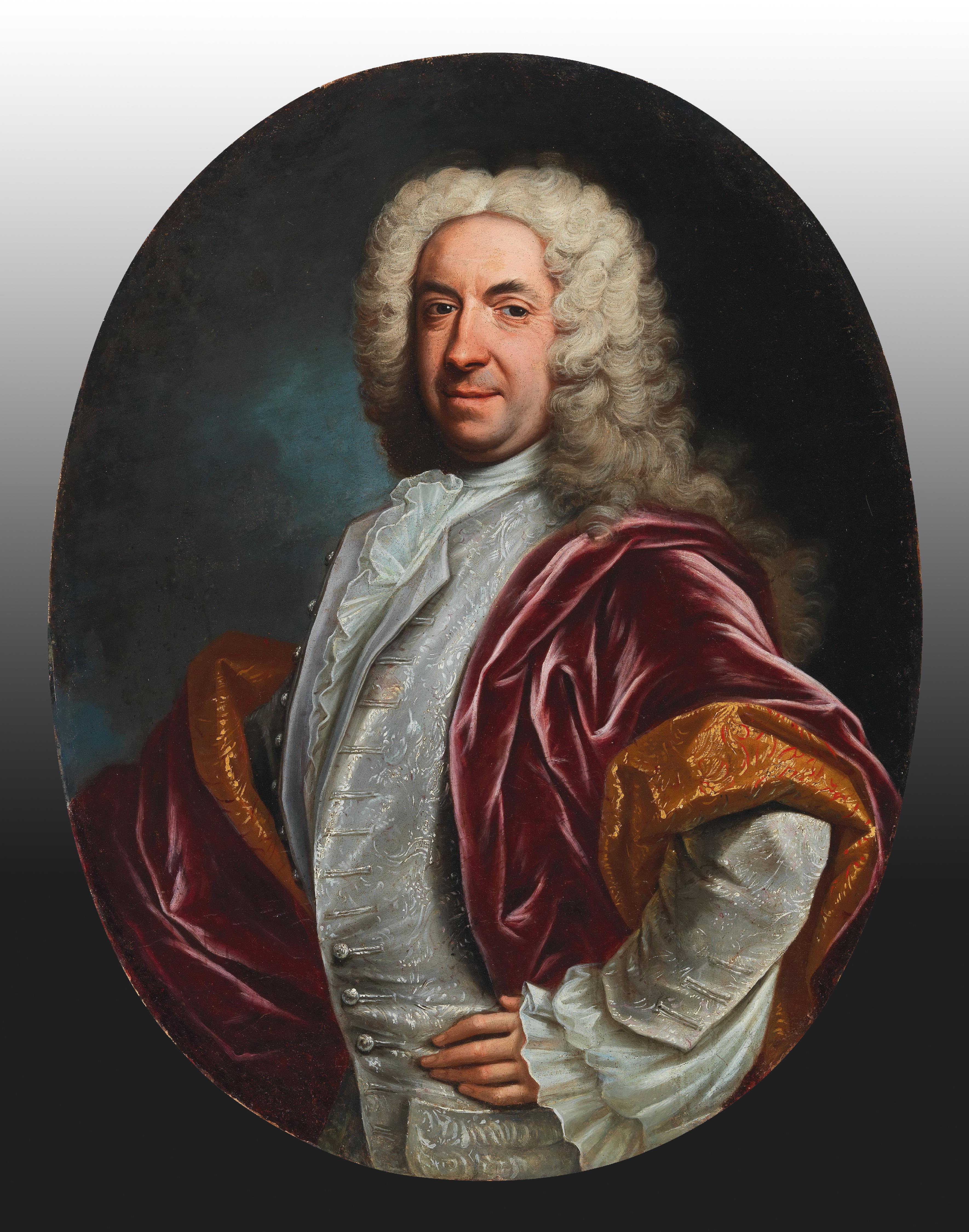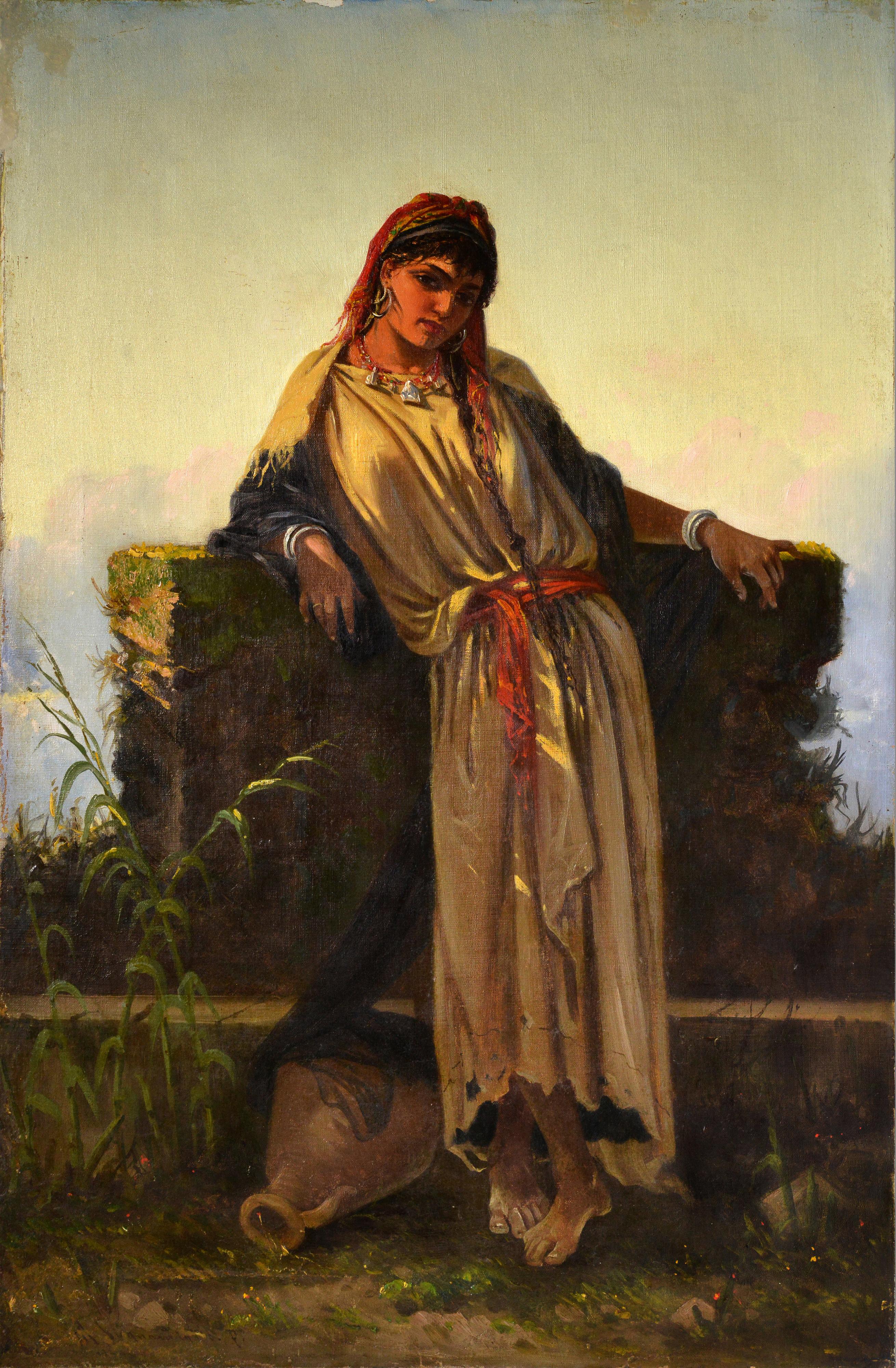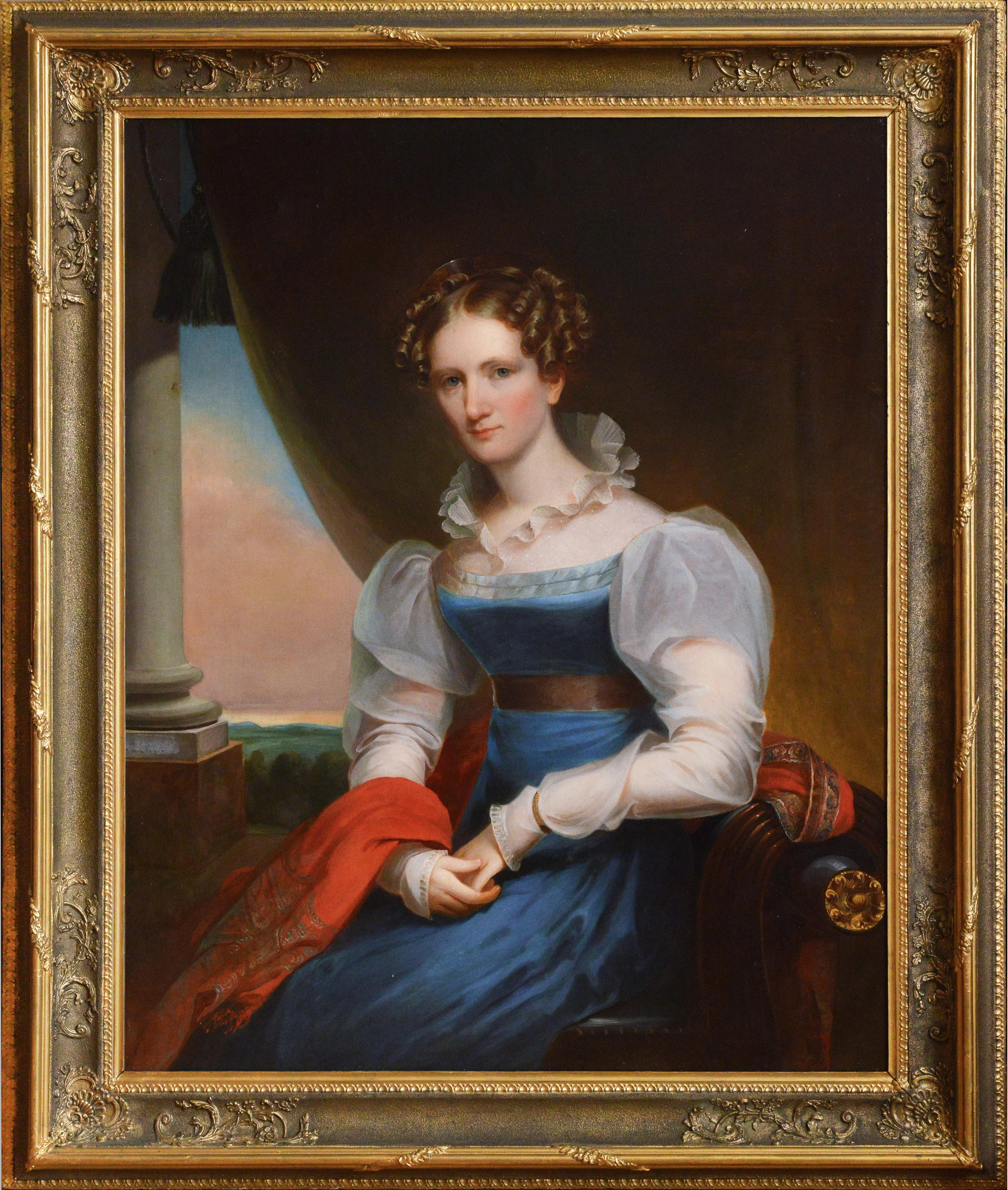Items Similar to Portrait on Stage - Red Cape - Scottish 60s art theatrical portrait oil painting
Want more images or videos?
Request additional images or videos from the seller
1 of 15
Doris ZinkeisenPortrait on Stage - Red Cape - Scottish 60s art theatrical portrait oil paintingCirca 1960
Circa 1960
About the Item
This stunning Scottish musical theatrical portrait oil painting is by female artist Doris Zinkeisen. Painted circa 1960 it is of a lady in a red cape on stage with instruments at her feet. Her face is illuminated and there is a rich curtain behind her. Zinkeisen had many artistic connections to the theatre in London and this may be from one of the productions she was involved with.
Provenance. Wiltshire estate.
Condition. Oil on canvas, image size 24 inches by 20 inches and in good condition.
Frame. Housed in a coloured gallery frame, 31 inches by 27 inches and in good condition.
Doris Clare Zinkeisen (1898-1991) was a Scottish theatrical stage and costume designer, painter, commercial artist, and writer. She was best known for her work in theatrical design. Doris Zinkeisen was born in Clynder House in Rosneath, Argyll, Scotland. Her parents were Welsh-born Clare Bolton-Charles and Victor Zinkeisen, a timber merchant and amateur artist from Glasgow. Her father's family were originally from Bohemia and had been settled in Scotland for two hundred years. She had a younger sister, Anna Zinkeisen, who also became an artist. The family left Scotland and moved to Pinner, near Harrow in 1909. Zinkeisen attended the Harrow School of Art for four years and won a scholarship to the Royal Academy Schools in 1917 together with her sister Anna. During World War I Zinkeisen served as a Voluntary Aid Detachment at a hospital in Northwood, Middlesex.Zinkeisen shared a studio in London with her sister during the 1920s and 1930s from where she embarked on her career as a painter, commercial artist, and theatrical designer.Zinkeisen's realist style made her popular as a portraitist and she became a well-known society painter. The subject matter of her paintings, society portraiture, equestrian portraiture, and scenes from the parks of London and Paris reflect the lifestyle of the upper class at the time. An early success was her 1925 portrait of the actor Elsa Lanchester.She also worked widely in other media as an illustrator and commercial artist including producing advertising posters for several British mainline railway companies and murals for the RMS Queen Mary. A 1939 poster for the London Underground, At the Theatre, was printed but never issued due to the start of World War II. In 1944, Doris and her sister Anna were commissioned by United Steel Companies (USC) to produce twelve paintings that were reproduced in the trade and technical press in Britain, Canada, Australia and South Africa. The images were subsequently collated in a book, This Present Age, published in 1946. Zinkeisen produced a number of posters for London and North Eastern Railway (LNER), Southern Railway (SR), and the London, Midland and Scottish Railway (LMS) in the 1930s. The posters often featured historical themes such as Berwick-upon-Tweed by LNER (1930) which shows Isabella MacDuff, Countess of Buchan being punished by Edward I for crowning Robert the Bruce at Scone in 1306. In 1935, John Brown and Company Shipbuilders of Clydebank commissioned both of the Zinkeisen sisters to paint the murals in the Verandah Grill, a restaurant and night-club on the ocean liner the RMS Queen Mary. The murals, on the theme of entertainment, depicted circus and theatre scenes and can still be seen on the ship, now permanently moored in Long Beach, California. Zinkeisen was also involved in planning the interior decoration which featured a parquet dance floor surrounded by black Wilton carpets, star-studded red velvet curtains and a sweeping illuminated balustrade whose colours changed in time with the music. Writing in Vogue in 1936, Cecil Beaton described the Verandah Grill as By far the prettiest room on any ship – becomingly lit, gay in colour and obviously so successful that it would be crowded if twice its present size. The largest mural was damaged during World War II by gunnery officers tacking charts to the poster board covering the mural. After the war, Zinkeisen restored the mural and reportedly painted a mouse in the mural so there would always be a mouse on the Queen Mary, a dig at Cunard, which prided itself on having no rodents on their ships. Both sisters also contributed murals to the RMS Queen Elizabeth in 1940. Zinkeisen exhibited at the Royal Academy in 1929, at the Royal Society of Portrait Painters in London and in Paris and the United States. She received Bronze (1929), Silver (1930) and Gold (1934) Paris Salon medals for her work. By 1929 she had been elected a member of the Royal Institute of Oil Painters (ROI). Zinkeisen was a successful stage and costume designer for plays and films. Despite her success as a painter and commercial artist she was best known as a theatrical designer. During World War II, Zinkeisen joined the St John Ambulance Brigade and worked as a nurse in London helping wartime Blitz casualties having first trained as a Voluntary Aid Detachment (VAD) nurse during World War I. She worked in the casualty department in St Mary's Hospital, Paddington. Zinkeisen worked in the casualty department in the mornings and painted in the afternoons, recording the events of the day. Following the liberation of Europe in 1945, Zinkeisen was commissioned by the War Artists' Advisory Committee as a war artist for the North West Europe Commission of the Joint War Organisation of the British Red Cross Society and the Order of St John (JWO). As the organisation's staff and resources moved into newly liberated areas, Zinkeisen's role as a war artist was to record the commission's activities. Based in Brussels at the commission's headquarters she recorded the commission's post-war relief work in north west Europe including the rehabilitation and repatriation of prisoners of war and civilian internees. Zinkeisen traveled by lorry or by air (from a nearby RAF base) throughout north-west Europe making sketches which she brought back to her studio in the commission's headquarters for further work. Her work as a war artist included three days at the Bergen-Belsen concentration camp in April 1945, immediately after its liberation. Zinkeisen was one of a small number of artists who produced pictures of Bergen-Belsen in the months following its liberation. The other artists there included Leslie Cole, Mary Kessell, Sergeant Eric Taylor (one of the camp's liberators), Edgar Ainsworth, and Mervyn Peake. Her painting Human Laundry shows German orderlies washing camp inmates before they go to hospital. By the time Zinkeisen had become a war artist her palette had already darkened from the colours of her society paintings. Her war paintings use muted greys, browns, and ochres like contemporaries such as Eric Ravilious and Stanley Spencer Paintings from Zinkeisen's time as a war artist are held by the Red Cross museum and archives, the museum of the Order of St John and the Imperial War Museum. Her work was part of the painting event in the art competition at the 1948 Summer Olympics. After the war, Zinkeisen continued to work in London as a theatrical designer and held occasional exhibitions of her paintings. She designed the cover of a special edition of Everybody's Magazine to celebrate the coronation of Queen Elizabeth II in June 1953. In 1954, Zinkeisen designed the scenery and costumes for Noël Coward's musical, After the Ball, based on Oscar Wilde's play, Lady Windermere's Fan, and the Prince Littler directed play, The Little Glass Clock, written by Hugh Mills. Zinkeisen married Edward Grahame Johnstone, a naval officer in 1927 and had twin daughters in June 1928, the children's book illustrators Janet and Anne Grahame Johnstone and a son, Murray Johnstone. Zinkeisen was a fine horsewoman and won the Moscow Cup at the International Horse Show in 1934. Grahame Johnstone died in 1946 and Zinkeisen's twin girls then lived with their mother moving with her to Suffolk in 1966. Zinkeisen outlived her daughter Janet who died in an accident in 1979. Doris Zinkeisen died on 3 January 1991, in Badingham, Suffolk, aged 92.
Exhibited: Royal Academy 9, Royal Scottish Academy 7, Glasgow Institute 1, Society of Women Artists 3, Royal Hibernian Academy 1 and Paris Salon.
- Creator:Doris Zinkeisen (1898 - 1991)
- Creation Year:Circa 1960
- Dimensions:Height: 31 in (78.74 cm)Width: 27 in (68.58 cm)Depth: 2 in (5.08 cm)
- Medium:
- Movement & Style:
- Period:
- Condition:
- Gallery Location:London, GB
- Reference Number:1stDibs: LU853113404242
About the Seller
5.0
Platinum Seller
These expertly vetted sellers are 1stDibs' most experienced sellers and are rated highest by our customers.
1stDibs seller since 2018
402 sales on 1stDibs
Typical response time: 1 hour
- ShippingRetrieving quote...Ships From: London, United Kingdom
- Return PolicyA return for this item may be initiated within 14 days of delivery.
More From This SellerView All
- The Soldier's Farewell - Scottish Victorian art Interior portrait oil paintingBy Robert Gemmell HutchisonLocated in London, GBThis lovely Scottish interior genre oil painting is by noted Scottish artist Robert Gemmell Hutchison. Painted circa 1890 Hutchison painted several versions of this scene of a young ...Category
19th Century Realist Interior Paintings
MaterialsOil
- Grandma and Grand Daughter in an Interior - British 40's Portrait oil paintingBy Anthony DevasLocated in London, GBThis lovely British interior portrait oil painting is by noted British artist Anthony Devas. Painted circa 1940 the painting is of a seated grandmother and grand daughter in a lovely...Category
1940s Realist Portrait Paintings
MaterialsOil
- The Evening of Life - Interior Portrait - British 1906 Newlyn Sch oil paintingBy Walter LangleyLocated in London, GBThis stunning, large British Edwardian Newlyn School interior portrait oil painting is by much noted and exhibited artist Walter Langley. Originally from Birmingham, Langley and his family moved to St Ives in 1881. He was one of the first artists to settle and painted the local fishermen and their families. Painted in 1906 and entitled The Evening of Life, the painting is a full length seated portrait of an elderly lady in a cottage interior. She is sat by a table on which she has a bible, jug of flowers and her sewing equipment. Across her lap she has a large patchwork quilt to mend but is lost in thought. In fact the same sitter and quilt can be seen in Memories, also painted in 1906 and in the Ferens Art Gallery, Hull. Memories includes more of the cottage interior but the sitter's head is bowed towards her hands. The Evening of Life is more vibrant and the sitters face is much more visible as are the lovely colours of the quilt. The painting has fantastic detail, great brushwork and the Newlyn school palette of colours. The provenance is excellent, having been kept in the same family ownership so fresh to market. The painting appeared in the artist's catalogue Raisonne and was also in 1997 biography by Langely's grandson, Roger Langley, entitled Walter Langley: Pioneer of the Newlyn Art Colony. This a superb example of Langley's work, a good size and composition and a pleasure to gaze upon. Signed lower left and dated (19)06. Provenance. : Ford, 1906 (£63). Long in the previous family ownership and sold by the executors of the estate. Thomas Wood and Sons label verso. Literature: Langley (R) - Walter Langley Pioneer of the Newlyn Art Colony 1997, catalogue raisonne p.170 (under 1906). Condition. Oil on canvas, 40 inches by 30 inches unframed, in good condition and unlined canvas. Frame. Housed in a gilt frame 47 inches by 37 inches and in good condition. Walter Langley (8 June 1852 – 21 March 1922) was an English painter and founder of the Newlyn School of plein air artists. He was born in Birmingham and his father was a journeyman tailor. At 15 he was apprenticed to a lithographer. At 21 he won a scholarship to South Kensington and he studied designing there for two years. The sometimes highly ornate work is mainly in gold and silver and in a Renaissance style. He returned to Birmingham but took up painting full-time, and in 1881 was elected an Associate of the Royal Birmingham Society of Artists. In the same year he was offered £500 for a year's work by a Mr Thrupp (a Birmingham photographer). With this money he and his family moved to Newlyn where he was one of the first artists to settle and began recording the life of the fishing community. Politically left wing for his era, he was noted for his social realist portrayals of working class figures, particularly fishermen and their families. He was a supporter of Charles Bradlaugh, a radical socialist politician. His own working-class background enabled him to identify with the villagers and the hardships they endured, many of his paintings reflect this sympathy with the working-class fisher-folk amongst whom he lived. One of the best known works is the watercolour For Men Must Work and Women Must Weep (1883; Birmingham Museum and Art Gallery) based on Charles Kingsley's poem The Three Fishers (1851). Another is Between The Tides (1901; Warrington Museum & Art Gallery). Although one of the first to settle in the Newlyn artists' colony Newlyn School, Langley initially benefited little from its growing fame, partly because of his working-class origins and partly because until 1892 he painted largely in watercolour rather than the more prestigious medium of oils. His early training in lithography gives his paintings a detail and texture that show his technical skills. In 1884, Langley was elected a member of the RBSA and continued to exhibit widely throughout the UK and abroad. Later in his career his reputation grew. One of Langley's paintings was singled out as "a beautiful and true work of art" by Leo Tolstoy in his book What is Art?, while in 1895 Langley was invited by the Uffizi to contribute a self-portrait to hang alongside those of Raphael, Rubens and Rembrandt in their collection of portraits of great artists. Today his work is considered "vital to the image of the Newlyn School" and "alongside Stanhope Forbes ... the most consistent in style and substantial in output". Exhibited: Royal Society of Artist Birmingham 57, Dudley Gallery 4, Dowdeswell Gallery 17...Category
Early 1900s Realist Portrait Paintings
MaterialsOil
- The School Room - Flemish 19th century art interior genre oil painting childrenBy Ferdinand de Braekeleer the ElderLocated in London, GBThis charming Flemish genre oil painting is attributed to Ferdinand de Braekeleer the Elder. Painted circa 1850 it is a fine realist genre scene of the interior of a school room, a t...Category
19th Century Realist Interior Paintings
MaterialsOil
- The Train Set - British 20's art interior oil portrait boy playing female artistBy Agnes L ReidLocated in London, GBThis charming oil painting is by British female artist Agnes L Reid. Painted circa 1920 the painting is of a little boy playing on the floor with his train set, with balloons and a b...Category
1920s Realist Portrait Paintings
MaterialsOil
- Portrait of Lady at Spinning Wheel - French 1901 interior portrait oil paintingBy William Albert AblettLocated in London, GBThis lovely Edwardian oil painting is by French artist William Albert Ablett. Dated 1901, the brush work and use of light are superb. Ablett has perfectly captured the movement and f...Category
Early 1900s Realist Portrait Paintings
MaterialsOil
You May Also Like
- Baroque Portrait of a gentleman 18th century Italian master by Domenico ParodiBy Domenico Parodi (Genoa, 1672 - 1742)Located in Stockholm, SEWe are grateful to Prof. Daniele Sanguineti for suggesting the attribution to Domenico Parodi (1672 - 1742). He dates the painting into the period between 1730 and 1740. Domenico Par...Category
1730s Realist Portrait Paintings
MaterialsCanvas, Oil
- "Night Murmurs, " Oil PaintingBy Mia BergeronLocated in Denver, COMia Bergeron's (US based) "Night Murmurs" is an original, handmade oil painting that depicts a man in a dark interior room with a yellow lamp lit on his bedside table. Mia Bergeron...Category
2010s Realist Portrait Paintings
MaterialsOil
- "Cabin Interior, " Oil PaintingBy Mia BergeronLocated in Denver, COMia Bergeron's (US based) "Cabin Interior" is an original, handmade oil painting that depicts a mounted deer head with antlers with sunlight streaming through a cabin window. Mia B...Category
2010s Realist Portrait Paintings
MaterialsOil
- Italian genre portrait Middle Eastern beauty at a well 19th century oil paintingLocated in Stockholm, SEBedouin girl posing for the painter in late sunlight (sunset). Was painted by Cavaliero Antonio Scognamiglio ca. 1870-1880, most likely in Cairo as similar work of smaller size was i...Category
Late 19th Century Realist Portrait Paintings
MaterialsCanvas, Oil
- American artist Portrait German lady 19th century Oil painting by J. EichholtzLocated in Stockholm, SECeremonial Portrait of Noble German Lady - amazing discovery of hidden monogram "J.E. 1826" disclosing Great American portraitist Jacob Eichholtz (17...Category
1820s Realist Portrait Paintings
MaterialsCanvas, Wood, Oil
- An Old Man Pointing at Pocket Watch, Artist 19th Century, European SchoolLocated in Bruges, BEAn Old Man Pointing at Pocket Watch Artist 19th Century European School Signature: Signed bottom left Medium: Oil on panel Dimensions: Image size 46 x 55,50 cmCategory
19th Century Realist Interior Paintings
MaterialsOil, Panel
Recently Viewed
View AllMore Ways To Browse
Large Or Vintage Oil Portraits
Cover Portrait
Portrait On Glass
Africa Portrait
Vintage Studio Portraits
Vintage 60s Art
Portrait Of Actor
Joint In Art
60s Designers
Vintage Women Portraits
Vintage Portraits Of Women
Portrait Of An Actor
Portraits Black Women
Portrait Black Women
Southern Portraits
Canada War Poster
Canadian War Poster
Vintage Children Portraits





